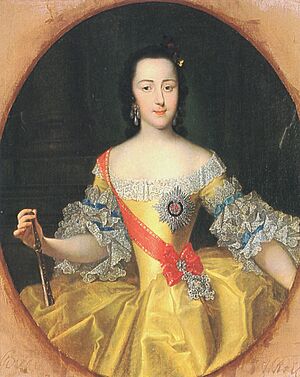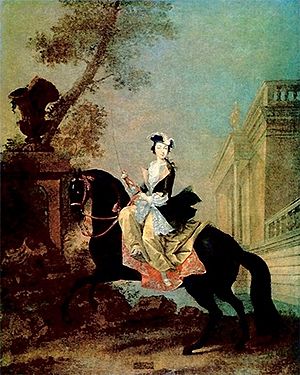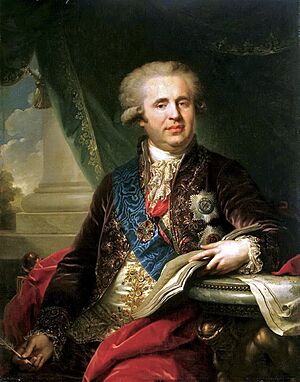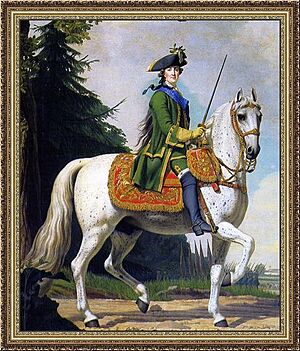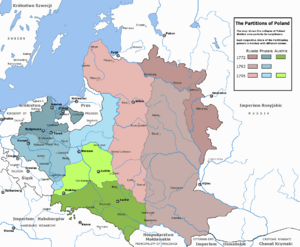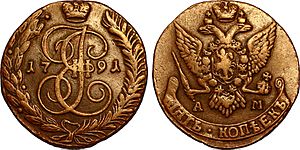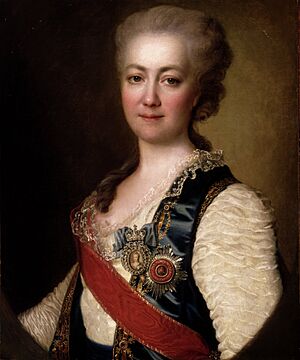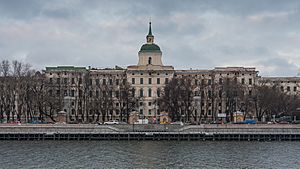Catherine the Great facts for kids
Quick facts for kids Catherine the Great |
|||||
|---|---|---|---|---|---|
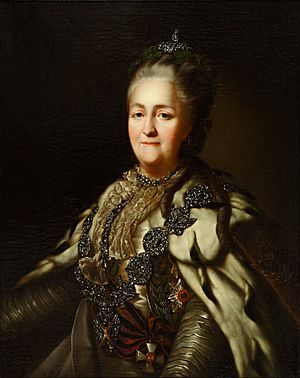
Portrait by Alexander Roslin, c. 1780s
|
|||||
| Empress of Russia | |||||
| Reign | 9 July 1762 – 17 November 1796 | ||||
| Coronation | 22 September 1762 | ||||
| Predecessor | Peter III | ||||
| Successor | Paul I | ||||
| Empress consort of Russia | |||||
| Tenure | 5 January – 9 July 1762 | ||||
| Born | Princess Sophie of Anhalt-Zerbst 2 May [O.S. 21 April] 1729 Stettin, Pomerania, Prussia, Holy Roman Empire (now Szczecin, Poland) |
||||
| Died | 17 November [O.S. 6 November] 1796 (aged 67) Winter Palace, Saint Petersburg, Russian Empire |
||||
| Burial | Saints Peter and Paul Cathedral, Saint Petersburg | ||||
| Spouse | |||||
| Issue among others... |
|
||||
|
|||||
| House |
|
||||
| Father | Christian August, Prince of Anhalt-Zerbst | ||||
| Mother | Joanna Elisabeth of Holstein-Gottorp | ||||
| Religion |
|
||||
| Signature | |||||
Catherine II (born Sophie of Anhalt-Zerbst; 2 May 1729 – 17 November 1796), known as Catherine the Great, was the empress of Russia from 1762 to 1796. She became empress after her husband, Peter III, was removed from power. During her long rule, Catherine was inspired by the ideas of the Enlightenment. Russia saw a great growth in culture and sciences. Many new cities, universities, and theaters were built. People from other parts of Europe moved to Russia. Russia became known as one of the most powerful countries in Europe.
Catherine often relied on her close advisors and generals. These included Grigory Orlov and Grigory Potemkin. Generals like Alexander Suvorov helped Russia expand its empire. Russia grew quickly through wars and clever agreements. In the south, Russia defeated the Ottoman Empire in the Russo-Turkish War. This led to Russia taking over the Crimean Khanate. Russia also gained land along the Black and Azov Seas. In the west, the Polish-Lithuanian Commonwealth was divided. Russia gained the largest part of this land. In the east, Russians were the first Europeans to settle in Alaska, creating Russian America.
Many new cities were founded by Catherine's orders. These included Odessa, Yekaterinoslav (now Dnipro), Kherson, Nikolayev, and Sevastopol. Catherine wanted to make Russia more modern, like Western Europe. However, many people were still serfs. Serfs were like peasants who were tied to the land. Their hard work supported the state and landowners. This led to rebellions, like Pugachev's Rebellion.
Catherine's rule is also called the Catherinian Era. During this time, Russian nobles were freed from forced military service. Many grand mansions were built in the classical style. Catherine supported the arts and learning. She started the Smolny Institute of Noble Maidens. This was the first state-funded higher education school for women in Europe.
Early Life of Sophie
Catherine was born Princess Sophie Friederike Auguste in Stettin, Prussia. Her family was part of the German nobility. Her father was a general in the Prussian army. Her mother was Joanna Elisabeth of Holstein-Gottorp. Sophie's family was not very rich. Her mother's wealthy relatives helped her rise to power.
Sophie received her education from French teachers. She learned French, which was a common language among European leaders. She also learned about etiquette and religion. Sophie met her future husband, Peter III of Russia, when she was 10 years old. She later wrote that she did not like him at first.
Becoming Empress: Catherine's Rise to Power
Princess Sophie was chosen to marry the future Russian emperor. This was part of a plan to make Prussia and Russia stronger allies. Sophie arrived in Russia in 1744. She worked hard to impress Empress Elizabeth, her future husband, and the Russian people. She studied the Russian language late into the night. She wanted to be ready to become empress.
Sophie became very ill soon after arriving in Russia. She believed that frequent bloodletting saved her. Her mother did not agree with this treatment. When Sophie was very sick, her mother wanted a Lutheran pastor to visit her. But Sophie asked for an Orthodox clergyman instead. This made Empress Elizabeth like Sophie even more.
On 28 June 1744, Sophie became a member of the Russian Orthodox Church. She took the new name Catherine (Yekaterina). She was named after Catherine I, the mother of Empress Elizabeth. On 21 August 1745, Catherine and Peter were married in Saint Petersburg. Catherine was 16 years old. They lived in a palace called Oranienbaum.
Their marriage was not happy. Peter was not mature, and they did not get along. Catherine started reading many books, especially from the French Enlightenment. She became very interested in how power works in politics. She learned to look for the "hidden motives" behind people's actions.
Peter III's Short Reign
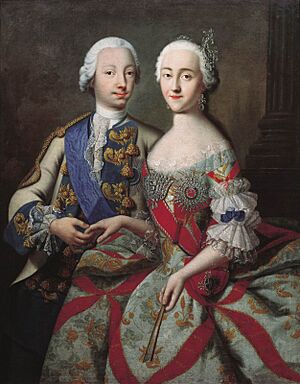
After Empress Elizabeth died on 5 January 1762, Peter became Emperor Peter III. Catherine became empress consort. They moved into the new Winter Palace in Saint Petersburg. Peter's behavior and decisions made many people unhappy. He greatly admired the Prussian King Frederick II. Russia had fought Prussia in the Seven Years' War. Peter stopped fighting Prussia, which angered many Russian nobles. He also planned a war against Denmark.
How Catherine Took the Throne
In July 1762, Peter was away at Oranienbaum. Catherine was at another palace nearby. On the night of 8 July 1762, Catherine learned that her plan to take power had been discovered. The next day, she went to the Ismailovsky Regiment. She asked the soldiers to protect her from her husband. The soldiers supported her.
Catherine then went to the Semenovsky Barracks. There, religious leaders declared her the sole ruler of Russia. She became Empress Catherine II. She had Peter arrested and forced him to give up his throne. Eight days later, on 17 July 1762, Peter III died. The official cause was illness, but many believe he was killed.
Other people could have claimed the throne, like Ivan VI. He had been held prisoner since he was a baby. Catherine gave orders that he should be killed if anyone tried to free him. He was killed during an attempt to free him later. Catherine was not from the House of Romanov family by birth. But she followed the example of Catherine I, who also became empress after her husband.
Catherine's Rule: Expanding Russia
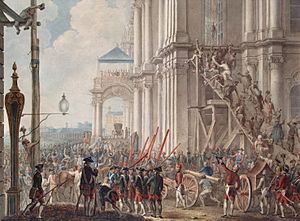
Catherine II was crowned in Moscow on 22 September 1762. For her coronation, the Imperial Crown of Russia was created. It was made with many diamonds and pearls. This crown was used for all Russian emperors until 1917. It is now in the Armoury Museum in Moscow.
Wars and New Lands
During her reign, Catherine greatly expanded the Russian Empire. She added about 200,000 square miles (520,000 km²) of land. This included New Russia, Crimea, parts of the North Caucasus, and much of the Polish-Lithuanian Commonwealth. These lands were mostly taken from the Ottoman Empire and Poland.
Catherine's foreign minister, Nikita Panin, tried to create alliances with other countries. Catherine also made a trade agreement with Great Britain in 1766.
Russia fought two major wars against the Ottoman Empire. The first war (1768–1774) was a big victory for Russia. Russia gained access to the Black Sea. New cities like Odessa and Kherson were founded. The Treaty of Küçük Kaynarca gave Russia more land and influence. It also made Crimea a protectorate of Russia. Catherine later fully took over Crimea in 1783.
The Ottomans fought Russia again in the second war (1787–1792). This war also ended with a Russian victory. The Treaty of Jassy confirmed Russia's control over Crimea.
Relations with Other Countries
Catherine wanted to be seen as an "enlightened" ruler. She often acted as a mediator in European disputes. For example, she helped settle the War of the Bavarian Succession (1778–1779). In 1780, she formed the First League of Armed Neutrality. This group aimed to protect neutral ships during the American Revolutionary War.
Russia also fought a war against Sweden from 1788 to 1790. Sweden's king, Gustav III, hoped to attack Saint Petersburg. But Russia's navy stopped the Swedish fleet. The war ended with a peace treaty, and all lands went back to their original owners.
Catherine played a big role in dividing Poland. In 1764, she helped her former lover, Stanisław August Poniatowski, become King of Poland. She then used her influence to control Poland's government. When Poland tried to make reforms, Catherine supported groups against these changes. After defeating Polish forces, Russia, Prussia, and Austria divided Poland three times (1772, 1793, and 1795). Poland stopped being an independent country until after World War I.
In the Far East, Russia tried to open trade with Japan. In 1792, a Russian mission went to Japan, but trade talks failed.
Life in Russia During Catherine's Time
How Russia Made Money
Russia's economy was not as developed as Western Europe's. Catherine tried to control merchants' activities, but this did not work well. She had more success by encouraging German farmers, called Volga Germans, to move to Russia. They brought new ideas for farming wheat, tobacco, and raising sheep.
In 1768, Russia started issuing its first paper money. This was needed because of the high cost of wars. Paper money helped the government pay for its needs. Catherine also worked on financial reforms. By 1781, the government had its first state budget.
Serfs: Life for Ordinary People
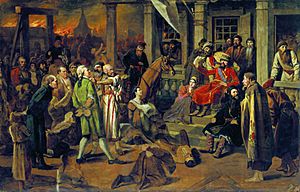
During Catherine's reign, many people in Russia were serfs. Serfs were peasants who belonged to landowners and were tied to the land they worked. Their children were also born into serfdom. Serfs had very few rights. They could not own land, but some managed to save money to buy their freedom.
Catherine made some small changes for serfs. They could now complain about their landowners through official channels. But they could no longer complain directly to the empress. Landowners could punish their serfs and even send them to hard labor in Siberia. However, they could not kill their serfs, as a serf's life belonged to the state.
Serfs often rebelled when they were unhappy. They usually blamed the nobles, thinking the empress meant well. But they were suspicious of Catherine because she had undone a law that would have freed serfs belonging to the Orthodox Church. The nobles also started to impose stricter rules on serfs.
This unhappiness led to Pugachev's Rebellion in 1774. A man named Pugachev pretended to be the true emperor. He promised to help the common people. Many serfs and peasants joined his cause. The rebellion was very violent but eventually failed. After the rebellion, Catherine became less interested in freeing the serfs. Despite her "enlightened" ideas, serfs generally remained unhappy during her rule.
Arts, Culture, and Learning
Catherine loved art, literature, and education. The Hermitage Museum started as her personal collection. She built the Hermitage in 1770 to hold her growing collection of paintings, sculptures, and books. By 1790, it had thousands of books and artworks. She also created the first "English garden" at Tsarskoye Selo.
Catherine was also fascinated by Chinese culture. She collected Chinese art and porcelain. She had the "Chinese Palace" built at Oranienbaum. Later, she hired a Scottish architect, Charles Cameron, to build the Chinese Village at Tsarskoye Selo.
She invited many smart people to Russia. She wrote her own plays, stories, and memoirs. She worked with famous French thinkers like Voltaire and Diderot. They helped spread her reputation. She also brought scientists from other countries to Russia.
Catherine wrote to Voltaire for 15 years. He praised her, calling her "The Star of the North." She bought his collection of books after he died. She also read many books on economics and law. She liked ideas about "enlightened despotism." This meant a ruler who was powerful but also made reforms based on laws.
In 1766, Catherine gathered a large commission in Moscow. It had 652 members from different social classes. They were supposed to discuss Russia's needs. Catherine wrote "Instructions for the Guidance of the Assembly." She used ideas from thinkers like Montesquieu. But many of her democratic ideas scared her advisors. The commission ended without making big changes.
Catherine did create new laws. In 1775, she divided Russia into provinces and districts to govern it better. In 1785, she gave more power to the nobles with the Charter to the Gentry. She also issued the Charter of the Towns, which organized city dwellers into groups.
During her reign, Russian writers like Gavrila Derzhavin started a new era of literature. Catherine supported Russian opera. However, when Alexander Radishchev wrote a book criticizing serfdom, Catherine had him exiled to Siberia. She saw his ideas as dangerous, especially after the French Revolution began.
Improving Education in Russia

Catherine believed that education could create a "new kind of person" in Russia. She wanted to modernize education across the country. She appointed Ivan Betskoy as her advisor on education. She also studied education systems in other countries.
In 1764, Catherine founded the Smolny Institute. This was the first school of its kind in Russia. It first admitted girls from noble families. Later, it also took girls from middle-class families. The girls learned French, music, and dancing. The school had strict rules, and discipline was very important.
Catherine also reformed the Cadet Corps in 1766. This school educated young boys from a very young age until they were 21. The curriculum included sciences, philosophy, and history. These changes influenced other military schools.
In 1786, Catherine created the Russian Statute of National Education. This law set up a system of free primary and high schools in provincial capitals. These schools were open to all free classes (not serfs) and were co-educational. Teachers were given guides on how to teach. By the end of Catherine's reign, about 62,000 students were in state schools. This was a big improvement, but still a small number compared to Russia's population.
Religion in Catherine's Empire
Catherine took control of the church's lands to help pay for her wars. She closed many monasteries. Most clergymen had to support themselves by farming or charging fees for services. The church lost much of its power.
Catherine also tried to protect Christians under Turkish rule. She was strict with Catholics, especially in Poland. But she allowed Jesuits to find safety in Russia after they were banned in most of Europe.
Different Faiths in Russia
Catherine had different approaches to Islam. She tried to persuade Muslims to join her empire peacefully. She offered money and other benefits if they converted to Orthodoxy. However, she also allowed Muslims to build mosques and practice their traditions. She created the Orenburg Muslim Spiritual Assembly to oversee Muslim regions. This helped the government regulate religious affairs.
In 1785, Catherine approved funding for new mosques and Muslim settlements. This was a way to encourage nomadic people to settle down. In 1786, she included Islamic schools in the Russian public school system. This allowed the government to control more people.
Judaism was treated differently. Until 1772, there were few Jews in Russia. When Russia gained Polish lands, many Jews became part of the empire. Catherine restricted Jews to certain areas called the Pale of Settlement. She also made them pay higher taxes than Orthodox Russians. If a Jewish family converted to Orthodoxy, the extra tax was removed. In 1785, Catherine declared Jews to be "foreigners" with fewer rights than other Russian citizens.
The Orthodox Church also saw changes. Catherine took over church lands and controlled their budgets. Many monasteries were closed. The Orthodox clergy had less power in government. Catherine also tried to bring back Old Believers (a religious sect) into the official church. She allowed them to practice their faith openly. Later, Old Believers were allowed to hold elected positions in towns.
Catherine also removed religious studies from public education. She wanted to separate the church from the daily workings of the state. She changed the clergy from a powerful group to one that depended on the state for support.
Catherine's Later Years and Legacy
Catherine had many close companions during her reign. She often gave them high positions and gifts of land and serfs. This helped her gain support from important people. One of her companions, Grigory Potemkin, became a very powerful advisor. He helped her with military plans and developing new lands in the south.
Catherine's last years saw some disappointments. Her plan for her granddaughter Alexandra to marry the King of Sweden did not work out. She also wanted her grandson Alexander to become her heir instead of her son Paul. But she died before she could make this official.
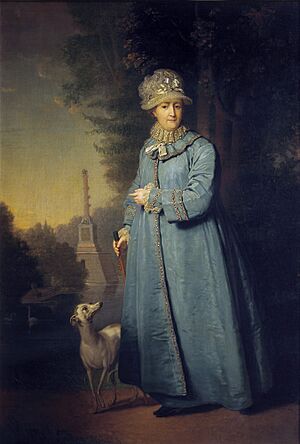
On 16 November 1796, Catherine woke up feeling well. But later that morning, she was found on the floor, very ill. Doctors said she had a stroke. She fell into a coma and died the next evening, on 17 November 1796, at the age of 67.
Catherine's will stated that she should be dressed in white with a golden crown. Her body was displayed for six weeks in the Winter Palace. People came to pay their respects.
Issue
| Name | Lifespan | Notes |
|---|---|---|
| Paul (I) Petrovich Emperor of Russia |
1 October 1754 – 23 March 1801 (Age: 46) |
Officially, he was the son of Peter III. Catherine's memoirs suggest his biological father was Sergei Saltykov. He became emperor in 1796. |
| Anna Petrovna Grand Duchess of Russia |
9 December 1757 – 8 March 1759 (Age: 15 months) |
Born at the Winter Palace. Empress Elizabeth raised her. Anna died at 15 months old. |
| Alexei Grigorievich Bobrinsky Count Bobrinsky |
11 April 1762 – 20 June 1813 (Age: 51) |
Born at the Winter Palace. His father was Grigory Orlov. He was made Count Bobrinsky in 1796. |
Images for kids
-
Tsar Peter III and his wife, the future Catherine the Great. He reigned only six months, and died on 17 July 1762.
-
A satire on Catherine's morals and on the Russo-Turkish war, from 1791
-
Stanisław August Poniatowski, the last King of Poland
See also
 In Spanish: Catalina II de Rusia para niños
In Spanish: Catalina II de Rusia para niños



